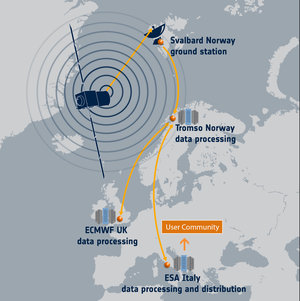Accept all cookies Accept only essential cookies See our Cookie Notice

About ESA
The European Space Agency (ESA) is Europe’s gateway to space. Its mission is to shape the development of Europe’s space capability and ensure that investment in space continues to deliver benefits to the citizens of Europe and the world.
Highlights
ESA - United space in Europe
This is ESA ESA facts Member States & Cooperating States Funding Director General Top management For Member State Delegations European vision European Space Policy ESA & EU Space Councils Responsibility & Sustainability Annual Report Calendar of meetings Corporate newsEstablishments & sites
ESA Headquarters ESA ESTEC ESA ESOC ESA ESRIN ESA EAC ESA ESAC Europe's Spaceport ESA ESEC ESA ECSAT Brussels Office Washington OfficeWorking with ESA
Business with ESA ESA Commercialisation Gateway Law at ESA Careers Cyber resilience at ESA IT at ESA Newsroom Partnerships Merchandising Licence Education Open Space Innovation Platform Integrity and Reporting Administrative Tribunal Health and SafetyMore about ESA
History ESA Historical Archives Exhibitions Publications Art & Culture ESA Merchandise Kids Diversity ESA Brand CentreLatest
Space in Member States
Find out more about space activities in our 23 Member States, and understand how ESA works together with their national agencies, institutions and organisations.
Science & Exploration
Exploring our Solar System and unlocking the secrets of the Universe
Go to topicAstronauts
Missions
Juice Euclid Webb Solar Orbiter BepiColombo Gaia ExoMars Cheops Exoplanet missions More missionsActivities
International Space Station Orion service module Gateway Concordia Caves & Pangaea BenefitsLatest
Space Safety
Protecting life and infrastructure on Earth and in orbit
Go to topicAsteroids
Asteroids and Planetary Defence Asteroid danger explained Flyeye telescope: asteroid detection Hera mission: asteroid deflection Near-Earth Object Coordination CentreSpace junk
About space debris Space debris by the numbers Space Environment Report In space refuelling, refurbishing and removingSafety from space
Clean Space ecodesign Zero Debris Technologies Space for Earth Supporting Sustainable DevelopmentLatest
Applications
Using space to benefit citizens and meet future challenges on Earth
Go to topicObserving the Earth
Observing the Earth Future EO Copernicus Meteorology Space for our climate Satellite missionsCommercialisation
ESA Commercialisation Gateway Open Space Innovation Platform Business Incubation ESA Space SolutionsLatest
Enabling & Support
Making space accessible and developing the technologies for the future
Go to topicBuilding missions
Space Engineering and Technology Test centre Laboratories Concurrent Design Facility Preparing for the future Shaping the Future Discovery and Preparation Advanced Concepts TeamSpace transportation
Space Transportation Ariane Vega Space Rider Future space transportation Boost! Europe's Spaceport Launches from Europe's Spaceport from 2012Latest

Proba-1 images Svalbard ground station
Thank you for liking
You have already liked this page, you can only like it once!
Long shadows cast across the snow give a frosty view of the covered domes of Europe’s most northerly ground station, as seen by the smallest camera on ESA’s veteran Proba-1 minisatellite.
The Svalbard Satellite Station sits on the island of Spitsbergen in the Norwegian archipelago of Svalbard in the Arctic Ocean. Operated by Kongsberg Satellite Services, it is the world’s largest commercial satellite ground station.
Located halfway between mainland Norway and the North Pole, Svalbard can track all 14 daily passes of polar-orbiting satellites, and has performed downlink duties for numerous ESA Earth-observing missions up to the present day.
It is an also an important site for Europe’s Galileo navigation satellites, hosting a sensor station to monitor signal quality and an uplink station to transmit navigation message updates to the satellite fleet.
In addition, Svalbard hosts one of Europe’s three terminals for relaying distress beacons detected by Galileo and other satellites to regional search and rescue services.
Note the slice of airstrip, cleared of snow, at the top of the image. Also free of snow is the road to the station, which stands 400 m above the airstrip. The island power plant can also be seen along the road. The Global Seed Vault, storing diverse crop seeds in the event of global disaster, is also located along the road, although not visible here.
The cubic-metre Proba-1 is the first in ESA’s series of satellites aimed at flight-testing new space technologies. It was launched in October 2001 but is still going strong after 14 years, having since been reassigned to ESA’s Earth observation duties.
Proba-1’s main hyperspectral CHRIS imager is supplemented by this experimental HRC high-resolution camera, acquiring black and white 5 m-resolution images.
Other innovations included what were then novel gallium-arsenide solar cells, the use of startrackers for gyroless attitude control, one of the first lithium-ion batteries – now the longest such item operating in orbit – and one of ESA’s first ERC32 microprocessors to run Proba-1’s agile computer.
This HRC image was acquired on 16 April 2016.
-
CREDIT
ESA -
LICENCE
ESA Standard Licence

KSAT ground station in Svalbard

Svalbard

Galileo IOV ULS/GSS site at Svalbard, Norway

Earth from Space: Svalbard Archipelago















 Germany
Germany
 Austria
Austria
 Belgium
Belgium
 Denmark
Denmark
 Spain
Spain
 Estonia
Estonia
 Finland
Finland
 France
France
 Greece
Greece
 Hungary
Hungary
 Ireland
Ireland
 Italy
Italy
 Luxembourg
Luxembourg
 Norway
Norway
 The Netherlands
The Netherlands
 Poland
Poland
 Portugal
Portugal
 Czechia
Czechia
 Romania
Romania
 United Kingdom
United Kingdom
 Slovenia
Slovenia
 Sweden
Sweden
 Switzerland
Switzerland






















